UMass Extension's Landscape Message is an educational newsletter intended to inform and guide Massachusetts land care professionals in the management of our collective landscape. Detailed reports from scouts and Extension specialists on growing conditions, pest activity, and cultural practices for the management of woody ornamentals, trees, and turf are regular features. The following issue has been updated to provide timely management information and the latest regional news and environmental data.
Welcome to Landscape Message #8 for the 2024 growing season. The next message will be published in one week, on June 7. To receive immediate notification when the next Landscape Message update is posted, be sure to join our e-mail list
Click on the headings below to jump to that section of the message.
In This Issue
Scouting Information by Region
Woody Ornamentals
Scouting Information by Region
Environmental Data
The following data was collected on or about May 29, 2024. Total accumulated growing degree days (GDD) represent the heating units above a 50ºF baseline temperature collected via regional NEWA stations (http://newa.cornell.edu) for the 2024 calendar year. This information is intended for use as a guide for monitoring the developmental stages of pests in your location and planning management strategies accordingly.
|
MA Region/Location |
2024 Growing Degree Days |
Soil Temp |
Precipitation |
Time/Date of Readings |
||
| Gain since last report |
2024 total |
Sun |
Shade |
|||
|
CAPE |
111 |
231 |
66 |
62 |
1.96 |
12:00 PM 5/29/2024 |
|
SOUTHEAST |
123 |
339 |
76 |
63 |
1.90 |
3:00 PM 5/29/2024 |
|
NORTH SHORE |
117 |
259 |
64 |
59 |
0.36 |
10:30 AM 5/29/2024 |
|
EAST |
134 |
353 |
75 |
67 |
1.03 |
4:00 PM 5/29/2024 |
|
METRO |
125 |
347 |
63 |
59 |
0.60 |
6:00 AM 5/29/2024 |
|
CENTRAL |
126 |
355 |
66 |
62 |
2.70 |
10:30 AM 5/29/2024 |
|
PIONEER VALLEY |
128 |
406 |
70 |
62 |
1.13 |
1:00 PM 5/29/2024 |
|
BERKSHIRES |
109 |
341 |
67 |
61 |
0.49 |
8:00 AM 5/29/2024 |
|
AVERAGE |
122 |
329 |
68 |
62 |
1.27 |
|
|
n/a = information not available |
||||||
US Drought Monitor: Once again, no change from last week... at this time, no area of Massachusetts is under official drought status. State map as of Thursday 5/29: https://droughtmonitor.unl.edu/CurrentMap/StateDroughtMonitor.aspx?MA
Phenology
| Indicator Plants - Stages of Flowering (BEGIN, BEGIN/FULL, FULL, FULL/END, END) | ||||||||
|---|---|---|---|---|---|---|---|---|
| PLANT NAME (Botanic / Common) | CAPE | S.E. | N.S. | EAST | METRO W. | CENT. | P.V. | BERK. |
|
Sambucus canadensis (American elderberry) |
* |
* |
* |
* |
* |
* |
Begin |
* |
|
Kalmia latifolia (mountain laurel) |
Begin |
Full |
* |
* |
Begin |
Begin |
Begin |
* |
|
Cotinus coggygria (common smokebush) |
Begin |
Begin |
Beigin |
Begin |
Begin |
Begin |
Begin |
* |
|
Weigela florida (old fashioned weigela) |
Begin/Full |
Full |
Begin/Full |
Begin/Full |
Begin/Full |
Begin/Full |
Full |
Begin/Full |
|
Robinia pseudoacacia (black locust) |
* |
Full |
Begin/Full |
Full |
Begin/Full |
Begin/Full |
Full |
Full |
|
Syringa meyeri (Meyer lilac) |
Begin/Full |
* |
Full |
Full |
Begin/Full |
Full |
Full |
Full |
|
Deutzia spp. (deutzia species) |
Full |
End |
Full |
Full |
* |
Full |
Full/End |
Full |
|
Aesculus hippocastanum (common horsechestnut |
Full |
Full/End |
Full |
Full |
Full |
Full |
Full |
Full |
|
Enkianthus campanulatus (redvein enkianthus) |
Begin/Full |
Full |
Full/End |
Full |
Full |
Full |
Full/End |
Full |
|
Rhododendron carolinianum (Carolina rhododendron) |
End |
* |
Full/End |
Full |
Full |
Full/End |
Full/End |
Full |
|
Rhododendron catawbiense (catawba rhododendron) |
Full |
Full |
Full |
Full |
Full |
Full |
Full |
Full |
| * = no activity to report/information not available | ||||||||
Regional Notes
Cape Cod Region (Barnstable)
General Conditions:
The average temperature for the period from May 22 thru May 29 was 65ºF with a high of 82ºF on May 24 and a low of 50ºF on May 25. Overall highs have been in the lower 70s, with lows around 60ºF. The period had two thunderstorm events on May 23 and May 28, and rainfall amounts varied widely across the Cape from the two storms. In Barnstable, a total of nearly 2.5 inches fell. Soil moisture is adequate.
Herbaceous plants seen in bloom during the period include bearded iris (Iris x germanica), lupine (Lupinus spp.), bluestar (Amsonia hubrichtii), and geraniums (Geranium sanguineum). Woody plants seen in bloom during the period include deciduous azaleas (Rhododendron spp.), golden chain tree (Laburnum anagyroides), doublefile viburnum (Viburnum plicatum), wisteria (Wisteria spp.), and dogwoods (Cornus spp). Pollen is abundant, primarily from white oak; pitch pine is beginning to flower.
Pests/Problems:

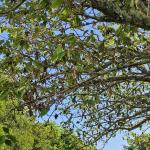

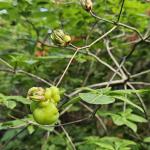
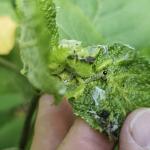
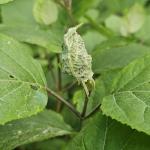 Insects or insect damage observed during the period includes winter moth damage to various trees and shrubs, turpentine beetle damage on pitch pine, some spongy moth caterpillars were observed in the lower and outer Cape area (these caterpillars were small, about ½ inch... keep an eye out for damage as they grow and eat more), box tree moth caterpillars on boxwood, viburnum leaf beetle on arrowwood viburnum, dogwood sawfly on alternate leaf dogwood, hydrangea leaf tier on smooth hydrangea, eriophyid mite gall on elm, hemlock wooly adelgid on hemlock, oak shothole leafminer damage on oak, columbine leafminer on columbine, and eastern tent caterpillar on black cherry.
Insects or insect damage observed during the period includes winter moth damage to various trees and shrubs, turpentine beetle damage on pitch pine, some spongy moth caterpillars were observed in the lower and outer Cape area (these caterpillars were small, about ½ inch... keep an eye out for damage as they grow and eat more), box tree moth caterpillars on boxwood, viburnum leaf beetle on arrowwood viburnum, dogwood sawfly on alternate leaf dogwood, hydrangea leaf tier on smooth hydrangea, eriophyid mite gall on elm, hemlock wooly adelgid on hemlock, oak shothole leafminer damage on oak, columbine leafminer on columbine, and eastern tent caterpillar on black cherry.
Beech leaf disease, which is widespread on ornamental and American beech, is readily visible on emerging foliage or lack thereof. Disease symptoms or signs observed during the period include brown rot on weeping cherry and ‘Kwanzan’ cherry, sycamore anthracnose on sycamore, volutella blight on boxwood, leaf spot on hosta, white pine needle decline on white pine, exobasidium gall on rhododendron, and red thread on turf.
Invasive plants seen in bloom during the period include leafy spurge (Euphorbia esula), scotch broom (Cytisus scoparius), winged euonymus (Euonymus alatus), and honeysuckles (Lonicera spp.). Other weeds seen in bloom include red sorrel (Rumex acetosella), white clover (Trifolium repens), black medic (Medicago lupulina), hawkweed (Hieracium pratense), and buttercups (Ranunculus spp.).
Rabbits, snails, and slugs are all active.
Southeast Region (Dighton)
General Conditions:
From May 22nd through the 29th, the highest temperature was 84ºF on Wednesday, May 22. The lowest, 54ºF, was also on the 22nd. Throughout the week there were light showers on Thursday, May 23, and thunderstorms forecast in the afternoon and evening of Wednesday, May 29. The total rainfall for the week was 1.05 inches. The highest wind speed was on Saturday the 26th from the south-southeast with gusts up to 16 mph. The average humidity was around 86%. Overall, the week was mostly sunny with some periods of clouds and precipitation. The soil temperature in full sun was 76ºF and in shade 63ºF at 3:00 PM on May 29th.
Plants currently in flower include Aesculus hippocastanum (common horsechestnut), Chionanthus virginicus (fringe tree), Deutzia spp. (Deutzia species), Euonymus alatus (winged euonymus), Elaeagnus umbellata (autumn-olive), Enkianthus campanulatus (redvein enkianthus), Kalmia latifolia (mountain laurel), Robinia pseudoacacia (black locust), Rhododendron catawbiense (catawba rhododendron), Spiraea x vanhouttei (Vanhoutte spirea), and Weigela florida (old fashioned weigela).
Pests/Problems
White ash trees are dropping leaves due to ash rust. Apple trees are dropping leaves due to scab.
Questing second-instar ticks will continue to be a threat to those working outdoors until August. These ticks will already have had a blood meal and therefore may be capable of transmitting Lyme disease. Mosquitoes are now hatching out in greater numbers. As the season progresses, there will be a greater potential for them to carry West Nile or Triple E viruses.
North Shore (Beverly)
General Conditions:
This reporting period brings us to the end of May. Temperatures were warmer and above average for this time of the year. Daytime temperatures ranged from mid-60s to low 80s and nighttime lows from the mid-50s to the mid-60s. The average daily temperature was 67ºF with the highest temperature of 82ºF recorded on May 24 and the lowest temperature of 53ºF recorded on May 25. Approximately 0.65 inch of rain was recorded at Long Hill. Memorial Day weekend was very pleasant and suitable for outdoor activities, with sunny skies and day temperatures in the mid 60s to low 70s. Many plants were in bloom during this period and for most plants the flower display has been very spectacular this year. Many azaleas and rhododendrons were in full bloom. Other woody plants seen in full bloom include sapphireberry (Symplocos paniculata), Chinese Neillia (Neillia sinensis), white Japanese wisteria (Wisteria floribunda 'Longissima alba'), slender deutzia (Deutzia gracilis), fringe tree (Chionanthus virginicus), doublefile viburnum (Viburnum plicatum var. tomentosum), American cranberrybush viburnum (Viburnum trilobum), beautybush (Kolkwitzia amabilis), mock orange (Philadelphus spp.), weigela (Weigela florida), and some azalea varieties. Some of the non-woody plants seen in bloom include fetterbush (Leucothoe fontanesiana), Scotch rose (Rosa spinosissima), peony (Paeonia spp.), cranesbill (Geranium spp.), bleeding heart (Dicentra spectabilis), Solomon’s seal (Polygonatum odoratum), blue star (Amsonia hubrichtii), geum (Geum chiloense), and several annuals.
Pests/Problems:
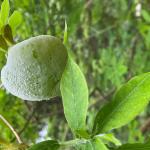
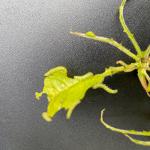
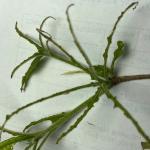
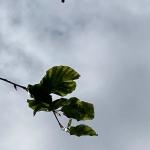

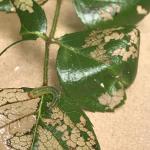
 Azalea sawfly was observed causing serious damage on some azaleas. They are completely defoliating azaleas leaving only the leaf veins. The larvae are small and green with tan heads and are difficult to see because they blend very well with the expanding leaves. Application of spinosad (ConserveTM) or another labeled insecticide can provide effective control.
Azalea sawfly was observed causing serious damage on some azaleas. They are completely defoliating azaleas leaving only the leaf veins. The larvae are small and green with tan heads and are difficult to see because they blend very well with the expanding leaves. Application of spinosad (ConserveTM) or another labeled insecticide can provide effective control.
Woolly beech aphids (Prociphilus fagi) were also observed on some beech trees. Woolly aphids produce a covering of fluffy white wax.
Beech leaf disease (BLD) is getting more serious on American beech trees.
Viburnum leaf beetles are enlarging and skeletonizing leaves of American cranberry bush viburnum and other susceptible viburnum varieties. Spray insecticidal soap to knock back viburnum leaf beetle larvae. Spinosad can also be used to manage viburnum leaf beetle larvae. Note that spinosad is toxic to pollinators until it dries.
Rose slug or rose slug sawfly (Endelomyia aethiops) caterpillars are enlarging and are causing damage to some roses. Rose slugs skeletonize leaves, leaving the veins intact. Use horticultural oil, insecticidal soaps, or spinosad, targeting the spray to the undersides of the leaves. Bacillus thuringiensis (Bt) will not control rose slug sawfly larvae.
Galls of azalea leaf and flower gall (Exobasidium vaccinii) are starting to develop the white spore layer. Prune them off immediately and discard them in the trash.
Weeds observed in bloom include ground ivy (Glechoma hederacea), garlic mustard (Alliaria petiolata), deadnettle (Lamium purpureum), common chickweed (Stellaria media), and common groundsel (Senecio vulgaris).
Because of the warm weather, mosquitoes and ticks are very active. Protect yourself with a repellent when working outdoors
East (Boston)
General Conditions:
The landscape is lush with new plant growth and colorful with many plants in bloom. Daytime temperatures over the past week averaged 80ºF, with a high of 89ºF on the 22nd. Overnight lows averaged 60ºF. We accumulated 0.06 inches of precipitation and have reached 332 GGD’s (base 50). There is an abundance of pollinator activity around the flowering plants. Seven spotted lady beetle larvae (Coccinella septempunctata) are feasting on aphids. Some plants in bloom include: Chionanthus virginicus (fringe tree), Kolkwitzia amabilis (beautybush), Laburnum anagyroides (golden chain tree), Papaver orientale (oriental poppy), Salvia officinalis (garden sage), Thymus vulgaris (garden thyme), and Weigela florida (weigela). The are several native populations of pink lady’s slipper (Cypripedium acaule) flowering in conservation areas in the Boston area.
Pests/Problems:
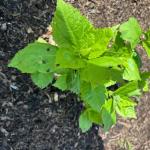 Insect activity is steadily rising. More of a nuisance than a threat to yews (Taxus spp.), the adult females of Pulvinaria floccifera (cottony Taxus scale) are active, laying eggs in white, fluffy masses on the underside of Taxus leaves. Another observation of a low-level pest to plant health is the boxwood psyllid (Psylla buxi). The adult psyllids are winged and can be seen coming out of the plants when disturbed. Hibiscus sawfly (Atomacera decepta) adults are busy depositing eggs into the foliage of hardy hibiscus (Hibiscus moscheutos) and hollyhock (Alcea rosea). These small black flies with a reddish, brown thorax towards the head, can be seen swarming the recently emerged hibiscus foliage. If left uncontrolled, the resulting larvae, which are small green caterpillar-like worms, can skeletonize entire plants. There can be up to six generations per year.
Insect activity is steadily rising. More of a nuisance than a threat to yews (Taxus spp.), the adult females of Pulvinaria floccifera (cottony Taxus scale) are active, laying eggs in white, fluffy masses on the underside of Taxus leaves. Another observation of a low-level pest to plant health is the boxwood psyllid (Psylla buxi). The adult psyllids are winged and can be seen coming out of the plants when disturbed. Hibiscus sawfly (Atomacera decepta) adults are busy depositing eggs into the foliage of hardy hibiscus (Hibiscus moscheutos) and hollyhock (Alcea rosea). These small black flies with a reddish, brown thorax towards the head, can be seen swarming the recently emerged hibiscus foliage. If left uncontrolled, the resulting larvae, which are small green caterpillar-like worms, can skeletonize entire plants. There can be up to six generations per year.
Metro West (Acton)
General Conditions:
Typical spring-like temperatures continued into this reporting period. It was cool, hot, windy and wet on any given day, including the holiday weekend. We did experience a bit of August weather with humidity and a high temperature of 90ºF on the 20th. A low temperature of 48ºF was recorded on the 25th. The average monthly rainfall for May is 4.04” and as of the 28th, I have recorded 2.2”. The fast-moving showers have been hit or miss across the state and have been frequent enough in this area to keep soils moist. The landscape is lush and colorful with all that is in bloom and the following woody and herbaceous plants were observed in some stage of bloom at this time: Baptisia australis (blue false indigo), Chionanthus virginicus (white fringetree), Cornus x rutgersensis 'Ruth Ellen' (Rutgers hybrid dogwood), Cotinus coggygria (common smokebush), Iris germanica (bearded Iris), I. sibirica (Siberian iris), Lonicera sempirvirens (trumpet honeysuckle), Philadelphus spp. (mock orange), Physocarpus opulifolius (common ninebark), Prunus serotina (black cherry), Robinia pseudoacacia (black locust), Viburnum sargentii (Sargent viburnum), and Weigela florida (old fashioned weigela).
Pests/Problems:
Many of our most invasive weeds have passed peak bloom and are beginning to set seed. Those include: Alliaria petiolata (garlic mustard), Berberis thunbergii (barberry), Euonymous alatus (burning bush), and Rhamnus cathartica (common buckthorn). Elaeagnus umbellata (Autumn-olive) continues to bloom. Ticks, mosquitoes and black flies are feeding and active.
Central Region (Boylston)
General Conditions:
A hot and humid week, but we are still receiving a good amount of rain this spring. Max precipitation was 0.99 inches on the 23rd, averaging 5.88 inches for May so far. Temperatures have averaged around 70.8ºF in the last week, the highest being 92.5ºF on the 22nd. Though the temperatures have been high, the soil seems to have stayed damp. Some woody plants that can be seen blooming currently are fringe tree (Chionanthus spp.), sweetshrub (Calycanthus spp.), sheep laurel (Kalmia angustifolia), and sweet abelia (Zabelia tyaihyoni). Some herbaceous material that also can be seen blooming is Phlox spp. (creeping and woodland phlox), chives (Allium schoenoprasum), eastern bluestar (Amsonia tabernaemontana), and Geranium spp. Also, the notorious and beautiful pink lady’s slipper (Cypripedium acaule) can be seen popping up in full bloom throughout forested areas, more typically in acidic soils.
Pests/Problems:
As mentioned in the previous report, beech leaf disease (BLD) seems to have a larger presence this growing season. It seems just within a week, more leaves have died back on different trees, even in uncultivated areas. Foliage damage from slugs is still present, though some new damage has emerged from the viburnum leaf beetle (Pyrrhalta viburni). The level of damage at this point is that most of the arrowwood viburnum (Viburnum dentatum) young leaves are now skeletonized and brown/dried up.
Pioneer Valley (Amherst)
General Conditions:
As May winds down, it really feels like summer across the Pioneer Valley. The landscape is lush with new growth and varying textures. The graceful layering of hemlock branches with lime green new growth contrasting with the dark older needles is one of the highlights of late May. Warm to hot and sometimes humid weather characterized this past reporting period. From 5/21 through 5/26, high temperatures crested in the middle to upper 80s with lows in the lower 60s. Recent summers have been very hot and humid in the valley and this season is starting off on a similar path. Bands of heavy rain and gusty winds gave most of the region a good soaking on 5/27, replenishing soil moisture in the upper horizons. Accumulations between 1–2” were recorded at several stations in western and central Franklin, Hampshire and Hampden counties. The eastern half of the tri-counties didn’t fare as well, with totals around 0.5”. The driving rain and strong winds overburdened some branches heavy with new growth and toppled many irises across the UMass campus. Black flies and mosquitoes are abundant, swarming and biting.
Pests/Problems:
Beech leaf disease, caused by the non-native foliar nematode Litylenchus crenatae ssp. mccannii, continues to be the most serious landscape and forest disease issue we’re currently facing. This disease will have a transformative impact on northern hardwood forests where beech is a primary component. When infestations are minor, the interveinal banding and convex cupping on the foliage can be nuanced. However, once the nematode becomes established, populations typically increase dramatically the following year. Serious infestations result in heavily banded, thickened, distorted and undersized foliage. Canopy thinning and dieback often begins in the lower half of the canopy and spreads upwards.
We have entered the time of year when symptoms of white pine needle damage are most severe. Older needle browning and shedding has or will soon reach its zenith for diseased trees. While not a lethal disease for eastern white pine, needle blights are a chronic stress that stress and weaken trees, making them susceptible to other diseases, insects and abiotic injury, such as drought.
Azalea sawfly larvae (Amauronematus azaleae) and fruitworm caterpillars (Orthosia sp. - suspected) were found on a variety of dwarf rhododendrons and azaleas. The azalea bark scale (Eriococcus azalea) was also found on a Korean azalea (Rhododendron yedoense var. poukhanense) and because the infestation was minor, the scales were manually crushed and removed. Their white, waxy outer coating makes them easy to find.
Exobasidium gall is starting to appear on susceptible azaleas and rhododendrons. Prune and remove the galls as they appear. Despite their ubiquity, rhododendrons and azaleas can be challenging to properly transplant from containers. Their fibrous roots become extremely dense, and the bark is very easily scraped away on the root flare. This makes disentangling the primary lateral roots or exposing the root flare a delicate matter. But circling and girdling roots must be addressed for plants to thrive. If rhododendrons and azaleas that have been established for several years are languishing, excavate the root flare to determine if girdling roots are present. Prune and remove as necessary.
Damage caused by larvae of the European pine shoot moth (Rhyacionia buoliana) was recently observed on eastern white pine (Pinus strobus ‘John’s Find’) and mugo pine (Pinus mugo). Infested candles were elongated but were brown and drooping, having been hollowed out by larval tunneling. The larvae are brownish in color with a black head and were found inside the dead shoots.
Defoliating caterpillars (ID unknown) were observed on Delphinium and lily leaf beetle (Lilioceris lilii) larvae are now present on a variety of lilies (Lilium). The bright red adult lily leaf beetles contrast strongly with the green lily leaves, making them easy to capture. The larvae, meanwhile, are coated with a “fecal shield”, which is a strange and yet effective adaptation to avoid predation.
Berkshire Region (West Stockbridge)
General Conditions:
Warmer than normal is the best description for the weather conditions over recent weeks and that trend continued through the past week. The normal daily high and low for late May in central Berkshire County is 70ºF/48ºF. Those temperatures were well exceeded at all three NEWA reporting sites. After reaching high temperatures on May 22 of 88ºF in North Adams, 87ºF in Richmond, and 85ºF in Pittsfield, the daily highs dropped a bit but still reached into the 80s on many days since then. The overnight low temperatures for the past week were also above normal with averages in the low to mid 50ºF range as opposed to the norm of mid to upper 40s. The soil has become somewhat dry but that turned around on Monday, May 27 when significant rain of nearly an inch fell in most locations. Soils are currently moist, making this a good time for setting out plant specimens. Natural and managed landscapes remain flush with color from woody plants and herbaceous perennials. Weeds are also flushed with flowers. Growth of turfgrass has accelerated.
Pests/Problems:
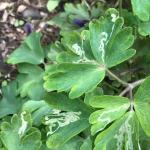

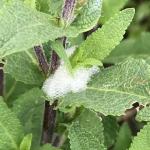 Increased pest activity has accompanied the warming trend. The deer tick population remains high, and it is important to continue with all the usual precautions and repellents to prevent tick bites and the risk of subsequent diseases such as Lyme disease. Caution should also be used to prevent stings from wasps and hornets as their activity has dramatically increased. Other than apple scab and rust, I have not found many plant diseases yet. On the other hand, pest problems have picked up. Among the problems observed are woolly beech aphid, boxwood psyllid, spruce spider mites, eastern tent caterpillar, and hydrangea leaftier. Another leaftier observed was the fern leaftier caterpillar (Herpetogramma). Columbine leaf miner (Phytomyza spp.) was busy making its way in the leaves of Aquilegia. The moisture has increased the number of slugs in garden settings and they have been gnawing on the foliage of numerous plants. Spittlebugs are evident on many plants but are not considered as serious pests. The wilting of shoots of black lace elderberry (Sambucus spp.) are a common sight for this plant and is caused by a borer.
Increased pest activity has accompanied the warming trend. The deer tick population remains high, and it is important to continue with all the usual precautions and repellents to prevent tick bites and the risk of subsequent diseases such as Lyme disease. Caution should also be used to prevent stings from wasps and hornets as their activity has dramatically increased. Other than apple scab and rust, I have not found many plant diseases yet. On the other hand, pest problems have picked up. Among the problems observed are woolly beech aphid, boxwood psyllid, spruce spider mites, eastern tent caterpillar, and hydrangea leaftier. Another leaftier observed was the fern leaftier caterpillar (Herpetogramma). Columbine leaf miner (Phytomyza spp.) was busy making its way in the leaves of Aquilegia. The moisture has increased the number of slugs in garden settings and they have been gnawing on the foliage of numerous plants. Spittlebugs are evident on many plants but are not considered as serious pests. The wilting of shoots of black lace elderberry (Sambucus spp.) are a common sight for this plant and is caused by a borer.
Regional Scouting Credits
- CAPE COD REGION - Russell Norton, Horticulture and Agriculture Educator with Cape Cod Cooperative Extension, reporting from Barnstable.
- SOUTHEAST REGION - Brian McMahon, Arborist, reporting from the Dighton area.
- NORTH SHORE REGION - Geoffrey Njue, Green Industry Specialist, UMass Extension, reporting from the Long Hill Reservation, Beverly.
- EAST REGION - Kit Ganshaw & Sue Pfeiffer, Horticulturists reporting from the Boston area.
- METRO WEST REGION – Julie Coop, Forester, Massachusetts Department of Conservation & Recreation, reporting from Acton.
- CENTRAL REGION - Mark Richardson, Director of Horticulture, and Anna Petrie, reporting from New England Botanic Garden at Tower Hill, Boylston.
- PIONEER VALLEY REGION - Nick Brazee, Plant Pathologist, UMass Extension Plant Diagnostic Lab, reporting from Amherst.
- BERKSHIRE REGION - Ron Kujawski, Horticultural Consultant, reporting from Great Barrington.
Woody Ornamentals
Diseases
Recent pests, pathogens, or problems of interest seen in the UMass Extension Plant Diagnostic Lab, a select few:
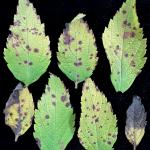 Bacterial leaf spot of Goldmound spirea (Spiraea japonica 'Goldmound') and Manhattan euonymus (Euonymus kiautschovicus 'Manhattan') caused by Xanthomonas. Containerized plants from separate nurseries in the region. Each group of plants experiences full sun with overhead watering. In early May, the spireas developed dark-colored, angular spots and blotches on the foliage. On some leaves, a marginal blight was also present. For the euonymus, they arrived at the nursery from the mid-Atlantic and after the frosts in late April, developed brown-colored, angular spots and blotches along with a marginal leaf blight. Xanthomonas is a large and taxonomically complicated genus with species and pathovars that infect a wide array of woody and non-woody plants. The tight spacing and overhead watering regimen that is standard at woody plant nurseries can create conditions conducive for disease development and spread. Bacterial leaf spot is not a serious disease for most woody ornamentals but in these cases, it reduces the salability of the plants.
Bacterial leaf spot of Goldmound spirea (Spiraea japonica 'Goldmound') and Manhattan euonymus (Euonymus kiautschovicus 'Manhattan') caused by Xanthomonas. Containerized plants from separate nurseries in the region. Each group of plants experiences full sun with overhead watering. In early May, the spireas developed dark-colored, angular spots and blotches on the foliage. On some leaves, a marginal blight was also present. For the euonymus, they arrived at the nursery from the mid-Atlantic and after the frosts in late April, developed brown-colored, angular spots and blotches along with a marginal leaf blight. Xanthomonas is a large and taxonomically complicated genus with species and pathovars that infect a wide array of woody and non-woody plants. The tight spacing and overhead watering regimen that is standard at woody plant nurseries can create conditions conducive for disease development and spread. Bacterial leaf spot is not a serious disease for most woody ornamentals but in these cases, it reduces the salability of the plants.
 Foliar anthracnose of winterberry (Ilex verticillata) caused by Colletotrichum. The plant is approximately 20 years old and resides in a residential landscape with half sun in a mulched bed beside the home. Symptoms include scattered marginal blight and curling of the developing leaves. Other winterberries on the site are unaffected. Anthracnose of winterberry can sometimes cause a fruit blight and diseased, mummified fruits in the canopy allow inoculum to linger into the following season. Colletotrichum has a broad host range and besides causing a foliar and fruit blight, can also create stem cankers. However cankering is not always present and often dependent on the particular host and setting.
Foliar anthracnose of winterberry (Ilex verticillata) caused by Colletotrichum. The plant is approximately 20 years old and resides in a residential landscape with half sun in a mulched bed beside the home. Symptoms include scattered marginal blight and curling of the developing leaves. Other winterberries on the site are unaffected. Anthracnose of winterberry can sometimes cause a fruit blight and diseased, mummified fruits in the canopy allow inoculum to linger into the following season. Colletotrichum has a broad host range and besides causing a foliar and fruit blight, can also create stem cankers. However cankering is not always present and often dependent on the particular host and setting.
Interior canopy dieback on eastern redcedar (Juniperus virginiana) due to an infestation of the spruce spider mite (Oligonychus ununguis) and needle blight caused by Pestalotiopsis. The tree is approximately 50 years old and experiences half sun with well-drained soils and lawn sprinklers providing some supplemental water. The managing arborist notes a uniform browning of the interior canopy. The lab has received several eastern redcedar samples in recent weeks with similar symptoms. In some cases, cedar-quince rust (Gymnosporangium clavipes) and Diplodia canker is also responsible for the dieback, but not in this particular case. The abundant rainfall last season has likely contributed to stem cankering and needle blight development within the interior canopy of these trees.
Report by Nick Brazee, Plant Pathologist, UMass Extension Plant Diagnostic Lab, UMass Amherst
Insects and Other Arthropods
The Professional Insect and Mite Management Guide for Woody Plants is freely available at https://ag.umass.edu/insectmiteguide. Please let me know how it is or isn’t working for you by responding to the following Feedback Form: Professional Insect & Mite Management Guide for Woody Plants. Your feedback is valuable and I cannot wait to hear from you!
Note: Our website is undergoing updates, and as such, the collapsible menus on the home page of the Guide are currently not functioning. Thank you for your patience as we await these updates.
Invasive Updates:
- Asian Longhorned Beetle is still present in Worcester, Shrewsbury, Boylston, West Boylston, and parts of Holden and Auburn, MA. If you suspect you’ve found this insect or the damage it causes, please report it to the Asian Longhorned Beetle Eradication Program office in Worcester, MA at 508-852-8090 or toll free at 1-866-702-9938.
To report an Asian longhorned beetle find online or to compare it to common insect look-alikes, visit: http://massnrc.org/pests/albreport.aspx
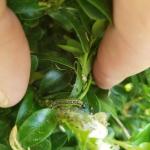 Box Tree Moth has been detected in the following Massachusetts communities: Bourne, Sandwich, and Barnstable. A map of these locations is available at MDAR’s Invasive Pest Dashboard. If you believe you have found this insect, please take a photo, note your location, and report it immediately to the MA Department of Agricultural Resources using their Report a Pest Form. Box tree moth caterpillars were reported to be active at certain locations on Cape Cod, MA as of the week of April 19th. For updates this week, see the Cape Cod Region Report.
Box Tree Moth has been detected in the following Massachusetts communities: Bourne, Sandwich, and Barnstable. A map of these locations is available at MDAR’s Invasive Pest Dashboard. If you believe you have found this insect, please take a photo, note your location, and report it immediately to the MA Department of Agricultural Resources using their Report a Pest Form. Box tree moth caterpillars were reported to be active at certain locations on Cape Cod, MA as of the week of April 19th. For updates this week, see the Cape Cod Region Report.
The USDA APHIS has announced a new quarantine for box tree moth in Massachusetts and Ohio, and has expanded existing quarantines in Michigan and New York. This includes conditions for interstate movement of regulated Buxus species. This quarantine includes the entire Commonwealth of Massachusetts. The federal order states:
“Boxwood plants may only be moved interstate from a quarantined area from an establishment operating under a compliance agreement, and only if accompanied by a certificate issued by a State Agricultural Authority certifying that the requirements of this Federal Order and the compliance agreement have been met. These requirements will prevent producers and distributors of boxwood from moving infested plants interstate. State Agricultural Authorities may prescribe additional safeguards and protocols.
All other regulated articles of boxwood, including plant parts, pieces, cuttings, clippings, debris, and any portion of the plant, alive or dead, except for decorative purposes, are prohibited from movement.”
MDAR has recently sent a notice to boxwood growers in Massachusetts of the following:
"Effective May 22, 2024, the USDA has issued a Federal Order establishing a quarantine for the entire state of Massachusetts. In an effort to restrict the movement of box tree moth, boxwoods (Buxus spp.) may no longer be exported from Massachusetts except by an establishment operating under a compliance agreement (CA) to be issued by MDAR. Anyone wishing to register for a CA must go to the Massachusetts Department of Agricultural Resources box tree moth page and click on the EXPORTS link, and fill out the form. An MDAR staff person will follow up within one week. Please note that the quarantine does NOT restrict in-state sales, movement within the state, or import of boxwoods into Massachusetts. If you have any further questions, please feel free to contact either MDAR (taryn.lascola@mass.gov) or USDA (203-741-5641)."
Need information about monitoring and trapping box tree moth? Check out this newly available Box Tree Moth Monitoring & Trapping fact sheet from UMass Extension.
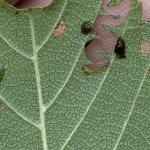
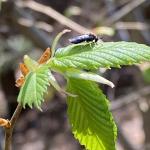 Elm Zigzag Sawfly has been detected in the following Massachusetts communities: Becket, Chester, Windsor, and Williamstown. If you believe you have found this insect, please take a photo, note your location, and report it immediately using MA DCR’s Massachusetts Elm Zigzag Sawfly Reporting Form. Elm zigzag sawfly adults are active as of 5/2/2024 at a previously infested site in Berkshire County (first detected in 2023). See photo courtesy of Nicole Keleher, MA DCR Forest Health Program.
Elm Zigzag Sawfly has been detected in the following Massachusetts communities: Becket, Chester, Windsor, and Williamstown. If you believe you have found this insect, please take a photo, note your location, and report it immediately using MA DCR’s Massachusetts Elm Zigzag Sawfly Reporting Form. Elm zigzag sawfly adults are active as of 5/2/2024 at a previously infested site in Berkshire County (first detected in 2023). See photo courtesy of Nicole Keleher, MA DCR Forest Health Program.- Emerald Ash Borer is well established across most of Massachusetts. A map of these locations from the MA Department of Conservation and Recreation is available.
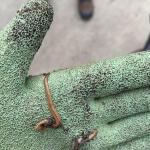
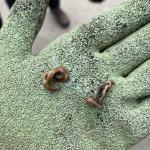 Hammerhead Worms: Also known as flatworms or land planarians, belong to Phylum Platyhelminthes (flat worms) rather than Arthropoda (arthropods) which makes them different from insects and their relatives. Class Insecta is the taxonomic classification of the Insects, whereas hammerhead worms belong to Class Turbellaria. A few common species of non-native hammerhead worms noted in New England include but are not limited to: Bipalium kewense, Bipalium adventitium, and Bipalium pensylvanicum. For more information, see this article in Hort Notes on Hammerhead Worms in New England.
Hammerhead Worms: Also known as flatworms or land planarians, belong to Phylum Platyhelminthes (flat worms) rather than Arthropoda (arthropods) which makes them different from insects and their relatives. Class Insecta is the taxonomic classification of the Insects, whereas hammerhead worms belong to Class Turbellaria. A few common species of non-native hammerhead worms noted in New England include but are not limited to: Bipalium kewense, Bipalium adventitium, and Bipalium pensylvanicum. For more information, see this article in Hort Notes on Hammerhead Worms in New England.
Sightings of these organisms have increased in recent years, possibly due to warming winters and wet summers. Hammerhead worms are predators that prefer to feed on earthworms; however, depending upon the species involved, they may not be an effective predator of certain species of jumping worms. Again in 2024, reports of hammerhead worms have come from parts of Massachusetts (in this case, Martha’s Vineyard; see photos) with questions about safety. Hammerhead worms are known to produce a neurotoxin (tetrodotoxin) which they use in self-defense and to subdue prey. Luckily, hammerhead worms do not produce enough tetrodotoxin to be lethal to humans, but if the neurotoxin comes into contact with exposed skin, irritation may occur. It is advised that handling hammerhead worms should be avoided, and hands or exposed skin be washed with soap and water following any accidental contact.- Jumping Worms are non-native earthworms that impact natural ecosystems. Available resources include a fact sheet about earthworms in Massachusetts and jumping worm FAQ’s.
- Spotted Lanternfly now has established populations in the following locations in Massachusetts: Holyoke, Springfield, West Springfield, Agawam, Fitchburg, Worcester, Shrewsbury, Southborough, Ashland, Wellesley, Weston, and Chelmsford. The MA Department of Agricultural Resources reports that spotted lanternfly egg hatch has begun in Holyoke and Springfield, MA as of 5/14/2024. Now is the time to monitor egg masses and areas nearby for emerging early instar nymphs (immatures). If you believe you have found this insect, please take a photo, note your location, and report it immediately using the Spotted Lanternfly Report Form. Available resources include a map of spotted lanternfly locations in Massachusetts from the MA Department of Agricultural Resources, MDAR’s spotted lanternfly fact sheet, UMass Extension’s Spotted Lanternfly Management Guide, and an SLF InsectXaminer episode.
Medically Important Pests:
- Ticks are a serious public health concern and may be active in managed landscapes any time temperatures are above freezing. Encounters with deer ticks can increase in New England in April, October, and November; however, precautions should be taken year-round to prevent tick bite exposure. Available resources include tick information from Cape Cod Cooperative Extension, personal protective measures, and a list of potential tick testing resources. The New England Center of Excellence in Vector-Borne Diseases (NEWVEC) also provides the latest tick information and resources.
- Mosquitoes and the diseases they vector are also a serious public health concern in Massachusetts by summer. Available resources include Mosquito Repellents from the Department of Public Health and Prevent Mosquito Bites from the Centers for Disease Control and Prevention. The Massachusetts Department of Public Health tests for Eastern Equine Encephalitis (EEE) and West Nile Virus (WNV) from June to October. Beginning in June, Massachusetts risk maps will be available.
- Wasps/Hornets: Many wasps are predators of other arthropods, including pest insects such as certain caterpillars that feed on trees and shrubs. Adult wasps hunt prey and bring it back to their nest where young are being reared as food for the immature wasps. A common such example are the paper wasps (Polistes spp.) who rear their young on chewed up insects. Paper wasps can sting, and will defend their nests, which are open-celled paper nests that are not covered with a papery “envelope”. These open-celled nests may be seen hanging from eaves or other outdoor building structures. Aerial yellow jackets and hornets create large aerial nests that are covered with a papery shell or “envelope”. Common yellow jacket species include those in the genus Vespula. Dolichovespula maculata is commonly known as the baldfaced hornet, although it is not a true hornet. The European hornet (Vespa crabro) is three times the size of a yellow jacket and may be confused for the northern giant hornet (Vespa mandarinia). The European hornet is known to Massachusetts, but the northern giant hornet is not. If you are concerned that you have found or photographed a northern giant hornet, please report it using the MA Department of Agricultural Resources Report Pest Sightings page. Some people are allergic to stinging insects, so care should be taken around wasp/hornet nests. Unlike the European honeybee (Apis mellifera), wasps and hornets do not have barbed stingers and therefore can sting repeatedly when defending their nests. It is best to avoid them and, if that cannot be done and assistance is needed to remove them, consult a professional.
Tree & Shrub Insect & Mite Pest Suggested Scouting:
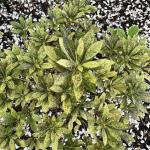 Andromeda Lace Bug is most commonly encountered on Japanese andromeda, however other host plants may be impacted. Most activity from this insect occurs between late May through September, with several generations occurring per year. Both nymphs and adults feed on host plant leaf undersides and cause white/yellow-colored spots or chlorosis to occur on host plant leaf surfaces. This image from 5/9/2024 (Boston, MA) shows Pieris japonica ‘Cavatine’ with old andromeda lace bug feeding damage from 2023 and possible winter injury. Samples were submitted to the UMass Extension Plant Diagnostic Lab. As of now, the new growth is starting to show damage as well, after developing without it. Boston, MA was at 132 GDD’s on 5/12/2024 and andromeda lace bug is known to begin activity by 120 GDD’s. (Image courtesy of Susan Shafer.)
Andromeda Lace Bug is most commonly encountered on Japanese andromeda, however other host plants may be impacted. Most activity from this insect occurs between late May through September, with several generations occurring per year. Both nymphs and adults feed on host plant leaf undersides and cause white/yellow-colored spots or chlorosis to occur on host plant leaf surfaces. This image from 5/9/2024 (Boston, MA) shows Pieris japonica ‘Cavatine’ with old andromeda lace bug feeding damage from 2023 and possible winter injury. Samples were submitted to the UMass Extension Plant Diagnostic Lab. As of now, the new growth is starting to show damage as well, after developing without it. Boston, MA was at 132 GDD’s on 5/12/2024 and andromeda lace bug is known to begin activity by 120 GDD’s. (Image courtesy of Susan Shafer.)- Arborvitae Leafminer moths appear from mid-June to mid-July and lay their eggs. Eggs hatch and larvae enter the leaves where they feed, often unnoticed until January or February when browned leaf tips become more apparent. Feeding from this insect is sometimes confused for winter injury, and vice versa.
- Azalea Lace Bug is a pest of both deciduous and evergreen azaleas (Rhododendron spp.), however resistance has been reported in Rhododendron atlanticum, R. arborescens, R. canescens, R. periclymenoides, and R. prunifolium. The insects feed on host plant leaf undersides, and cause chlorosis on leaf surfaces. Azalea lace bugs are active from 120+ GDD’s throughout the summer.
- Azalea Sawflies is a common name that might refer to three different species of sawflies that feed on azaleas. Adults of Amauronematus azaleae are often present in May and laying eggs which hatch into larvae that typically mature by July 1st. At that time, they finish feeding and drop to the soil to pupate. These green larvae feed on the edges of host plant leaves and may defoliate the plant.
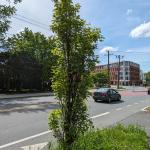
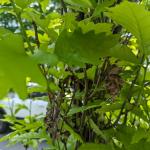

Bagworm is overwintering on Juniperus spp., Thuja spp., Quercus spp., Platanus spp., and others as 500-1000 eggs can be found in the bags of last season’s deceased females. Warmer areas of Massachusetts that are approaching or at 600 GDD's should be monitoring for bagworm egg hatch NOW! Look for the very small, young caterpillars who nearly immediately begin creating "bags" over themselves tied together with silk and bits of their host plants (leaves, bark, etc.). Early instar caterpillars (below 2/3 inch in length) are very susceptible to Btk (Bacillus thuringiensis Kurstaki). Apply to actively feeding, young caterpillars once all eggs have hatched, but before caterpillars exceed 2/3 inch in length. For great photos of early-instar bagworms, visit The Ohio State University Extension's Buckeye Yard & Garden onLine (BYGL).

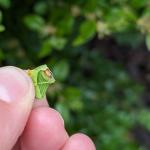 Boxwood Leafminer adult emergence occurs by mid-May, with pupal cases left behind clinging to leaves. Boxwood leafminer pupae were found in boxwood leaves in Berkshire County (Dalton, MA) on 5/11/2024. Shake bushes to detect flying adults. Resistant varieties of boxwood are available; see preceding link.
Boxwood Leafminer adult emergence occurs by mid-May, with pupal cases left behind clinging to leaves. Boxwood leafminer pupae were found in boxwood leaves in Berkshire County (Dalton, MA) on 5/11/2024. Shake bushes to detect flying adults. Resistant varieties of boxwood are available; see preceding link.
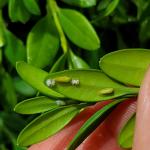
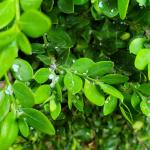 Boxwood Psyllid nymphs have overwintered within eggshells inserted between bud scales last summer. As soon as buds expand, nymphs will emerge and begin feeding on Buxus spp. developing buds and leaves. Upward cupping and yellowing of leaves can be a sign of previous or current season’s damage. Boxwood psyllids are actively feeding in Berkshire County (Dalton, MA) as seen on 5/11/2024. White, waxy wool created by the insects can be seen in new growth that has already cupped around the insects.
Boxwood Psyllid nymphs have overwintered within eggshells inserted between bud scales last summer. As soon as buds expand, nymphs will emerge and begin feeding on Buxus spp. developing buds and leaves. Upward cupping and yellowing of leaves can be a sign of previous or current season’s damage. Boxwood psyllids are actively feeding in Berkshire County (Dalton, MA) as seen on 5/11/2024. White, waxy wool created by the insects can be seen in new growth that has already cupped around the insects.
Boxwood psyllid activity may be very noticeable at this time if the population is large enough. Leaves may appear covered in "sticky snow". See photo by JoAnne Palmer taken on 5/23/2024 in Holyoke, MA.
- Cankerworms can be found feeding on similar host plants in the spring, despite fall and spring cankerworm being different species of insects. Spring cankerworm adult moths are active in February and March, laying masses of 100 or so eggs in the rough bark of larger branches or the trunk of the host plant. Fall cankerworm adults laid their masses of eggs on host plant branches and twigs, back in late November and early December of last year (sometimes the current year’s January). Egg hatch of both species will occur by approximately mid-May, with caterpillar feeding through roughly the end of June.
- Cooley Spruce Gall Adelgid typically overwinters as an immature female near spruce twig terminals. By early spring, this female matures into a stem mother which will lay hundreds of eggs on lateral terminals. Following egg hatch, nymphal feeding induces gall formation on spruce hosts. Green galls on spruce may be removed and destroyed. On Douglas fir, the Cooley spruce gall adelgid’s alternate host, look for woolly masses in the spring and distorted or crooked needles. Do not plant spruce and Douglas fir close together when possible.
- Dogwood Borer is a species of clearwing moth whose larvae bore not only into dogwood (Cornus), but hosts also include flowering cherry, chestnut, apple, mountain ash, hickory, pecan, willow, birch, bayberry, oak, hazel, myrtle, and others. Kousa dogwood appears to be resistant to this species. Signs include the sloughing of loose bark, brown frass, particularly near bark cracks and wounds, dead branches, and adventitious growth. The timing of adult emergence can be expected when dogwood flower petals are dropping and weigela begins to bloom. Adult moth flights continue from then until September.
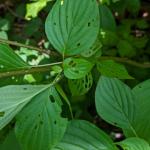
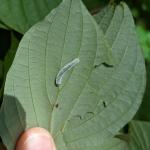 Dogwood Sawfly eggs have hatched and young sawflies are munching their way through dogwood leaves. See photos taken on 5/28/2024 in Chesterfield, MA. Dogwood sawflies are not susceptible to Btk (Bacillus thuringiensis Kurstaki) however, spinosad should be effective on young dogwood sawfly larvae.
Dogwood Sawfly eggs have hatched and young sawflies are munching their way through dogwood leaves. See photos taken on 5/28/2024 in Chesterfield, MA. Dogwood sawflies are not susceptible to Btk (Bacillus thuringiensis Kurstaki) however, spinosad should be effective on young dogwood sawfly larvae.- Eastern Tent Caterpillar overwintering eggs hatch in the spring and caterpillars emerge as cherry leaves begin to open. Anecdotally, eastern tent caterpillar activity has been more noticeable in Massachusetts in 2024. Tents and caterpillars in warm locations are large at this time. Many eastern tent caterpillars may have already pupated, however some can still be seen wandering through the landscape as of 5/30/2024.

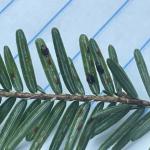 Elongate Hemlock Scale is primarily a pest of hemlock and fir. Overwintered fertilized females or their eggs will become active with warming temperatures, with egg hatch generally occurring by the end of May or the beginning of June. At that time, crawlers will be present before they settle to feed on a needle. Treatments for the crawler, or mobile, stage of this insect may be made in late May through mid-June, or between 360-700 GDD's, base 50F. Nitrogen fertilizer applications may make elongate hemlock scale infestations worse.
Elongate Hemlock Scale is primarily a pest of hemlock and fir. Overwintered fertilized females or their eggs will become active with warming temperatures, with egg hatch generally occurring by the end of May or the beginning of June. At that time, crawlers will be present before they settle to feed on a needle. Treatments for the crawler, or mobile, stage of this insect may be made in late May through mid-June, or between 360-700 GDD's, base 50F. Nitrogen fertilizer applications may make elongate hemlock scale infestations worse.
Colletotrichum fioriniae was observed on elongate hemlock scales in Lynnfield, MA on 2/23/2024 and again in Manchester, MA on 3/19/2024 by Richard Grant (see photos). C. fioriniae is an endophytic fungus that lives within the needles of hemlock. Up to 90% mortality can occur in elongate hemlock scale if this fungus invades the insect. Scales appear coated in a black material, looking similar to sooty mold (it is not sooty mold). This fungus was reported as active in elongate hemlock scale populations in western MA in 2023 as well.
- Euonymus Caterpillar tiny, overwintered larvae have spent their time beneath eggshells from last year. As temperatures increase in the spring, groups of caterpillars will begin feeding on newly emerging Euonymus spp. leaves. Additional resources include an InsectXaminer episode about euonymus caterpillar. By late June, euonymus caterpillars will pupate and the majority of their feeding for the 2024 growing season will be complete.
- Euonymus Scale overwinters as a fertilized female. Eggs are laid beneath dark brown female scale covers in the early spring. Egg hatch occurs over a 2-3 week period, with crawlers present by early June. While Euonymus spp. host plants are preferred, additional host plants have been reported.
- European Elm Scale is a non-native scale that is widespread in North America on native and European elms, in addition to hackberry and Zelkova. Adult females are black with a ring of white fibers around their bodies and may be found in branch forks or rough/creviced areas of the bark. By the end of June, females will produce eggs that hatch into crawlers. Crawlers will disperse to the underside of elm leaves and leaf midveins to feed.

 European Pine Sawfly eggs have overwintered in slits in last year’s needles. Egg hatch begins in approximately late-April and early May. Young European pine sawfly caterpillars were seen feeding in Berkshire County (Dalton, MA) on 5/11/2024. Look for tiny, gray-green larvae with black heads feeding on favored host plants such as Jack, Japanese red, Mugo, red, Scots, or Table Mountain pine. Sawfly larvae will feed until roughly early June, at which time they drop to the ground to pupate.
European Pine Sawfly eggs have overwintered in slits in last year’s needles. Egg hatch begins in approximately late-April and early May. Young European pine sawfly caterpillars were seen feeding in Berkshire County (Dalton, MA) on 5/11/2024. Look for tiny, gray-green larvae with black heads feeding on favored host plants such as Jack, Japanese red, Mugo, red, Scots, or Table Mountain pine. Sawfly larvae will feed until roughly early June, at which time they drop to the ground to pupate.- Fletcher Scale is a soft scale pest of yew, juniper, and arborvitae. Feeding scales, especially on yew, result in honeydew and sooty mold, needle yellowing, and at times, premature needle drop. There is one generation per year. Nymphs develop and adult females lay eggs (on average 500-600) in May that hatch by June. Dead females conceal egg masses beneath. Crawlers migrate short distances to branches and may be concentrated on certain branches of a particular plant.
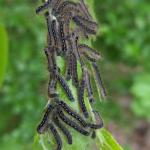 Forest Tent Caterpillar egg masses overwinter and will hatch as leaves expand in the spring. Small caterpillars will search for expanding flower and leaf buds to begin feeding on. In warmer locations of Massachusetts, forest tent caterpillars are large and may be reaching maturity. On 5/21/2024 in Chesterfield, MA, a group of much smaller, younger instar forest tent caterpillars was observed.
Forest Tent Caterpillar egg masses overwinter and will hatch as leaves expand in the spring. Small caterpillars will search for expanding flower and leaf buds to begin feeding on. In warmer locations of Massachusetts, forest tent caterpillars are large and may be reaching maturity. On 5/21/2024 in Chesterfield, MA, a group of much smaller, younger instar forest tent caterpillars was observed.
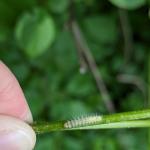
 Grape Plume Moth caterpillars were seen webbing terminal wild grape leaves together as they feed on 5/28/2024 in Chesterfield, MA. These caterpillars rarely occur in large enough numbers to warrant management. The adult moth is a member of Family Pterophoridae and is visually very striking.
Grape Plume Moth caterpillars were seen webbing terminal wild grape leaves together as they feed on 5/28/2024 in Chesterfield, MA. These caterpillars rarely occur in large enough numbers to warrant management. The adult moth is a member of Family Pterophoridae and is visually very striking.- Hemlock Looper collectively refers to two species of geometrid (inchworm; looper) caterpillars. Overwintered eggs hatch by late May or early June, at which time young larvae begin their messy feeding on host plant needles. Hemlock and balsam fir are preferred hosts. Hemlock looper caterpillars mature slowly, and may not begin pupation until late July with adults emerging by September and October.
- Hemlock Woolly Adelgid has been favored this winter by the mild temperatures we’ve experienced in Massachusetts, according to the MA Department of Conservation and Recreation. Very little overwintering mortality has been measured at sites sampled across the state. Hemlock woolly adelgid completes most of its development from October (of the previous season) through June. During the hot summer months (beginning in July), HWA spends its time as a first instar nymph (barely visible) at the base of hemlock needles. During that time, it is in a summertime dormancy known as aestivation.
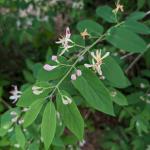
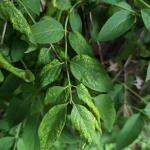
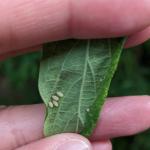 Honeysuckle Aphid is the likely culprit causing leaf curling seen in Williamsburg, MA on honeysuckle on 5/17/2024. This European species of aphid was first detected in North America in Quebec in 1976 and Illinois in 1981. Since then, it has been detected in New England and spread rapidly elsewhere in the United States, likely anywhere bush honeysuckle is grown. Green-colored aphids may be found on the newly opened leaves of host plants in the spring. Look for stunted and curled leaves.
Honeysuckle Aphid is the likely culprit causing leaf curling seen in Williamsburg, MA on honeysuckle on 5/17/2024. This European species of aphid was first detected in North America in Quebec in 1976 and Illinois in 1981. Since then, it has been detected in New England and spread rapidly elsewhere in the United States, likely anywhere bush honeysuckle is grown. Green-colored aphids may be found on the newly opened leaves of host plants in the spring. Look for stunted and curled leaves.- Hydrangea Leaftier caterpillars use silk applied to the edges of two newly expanding hydrangea leaves to tie them together to create an envelope-like structure within which they feed. Search the tips of plant stems. Envelope or purse-like structures may be pulled apart and caterpillars detected within. Caterpillars may mature and pupate by June.
- Imported Willow Leaf Beetle adults overwinter in loose bark or other sheltered areas near susceptible Salix and Populus spp. host plants. Once the host plant leaves emerge in the spring, adults will begin to feed and lay tiny, yellow eggs in clusters on leaf undersides. Additional resources include an InsectXaminer episode about imported willow leaf beetle.
- Lecanium Scales, including most notably in Massachusetts, the oak lecanium, are soft scales that overwinter on host plant twigs as second instar immatures. In the spring, these immatures begin feeding and mature into hemispherical shaped adult females who lay their eggs by late May and into June. Between April and May, much honeydew (sugary excrement) may be produced by the active adult females.
- Lily Leaf Beetle, while not a pest of trees and shrubs, can be an important insect found in ornamental landscapes. As soon as lilies break through the ground in the spring, bright red overwintered adult beetles begin feeding on the foliage. This typically occurs in April, with adults mating and laying eggs by May; 250-450 eggs may be laid per female. Additional resources include an InsectXaminer episode about lily leaf beetle.
- Magnolia Scale overwinters as nymphs (immatures) found on 1 and 2-year old twigs of the host plant. Nymphs begin feeding as temperatures warm in the spring, molting once by late April or May and again by early June.
- Oak Apple Galls: Several species of gall wasps cause structures referred to as oak apple galls. A common species mentioned in Johnson and Lyon (1991) is Amphibolips confluenta, which forms large galls that are attached to the midrib or petiole of oak leaves. Additional species in this genus are known to cause oak apple galls, including A. quercusinanis and A. quercusspongifica. A. confluenta galls are filled with a spongy mass that may be cut with a knife. A single wasp larva is found within a hard, seed-like cell in the center of the gall. As the gall dries, the spongy interior becomes a mass of fibers radiating from this central cell to the thin shell of the gall. These galls do no damage to their host plants and do not require management. Not enough is known about gall forming insects and there is so much to learn! Oak apple galls were green and of various sizes in Sandy Hook, CT on 5/18/2024.
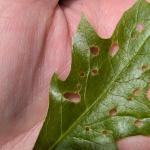
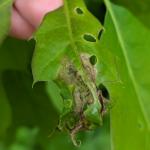
 Oak Shothole Leafminer activity in Massachusetts has alternated between elevated and lacking in certain areas in recent years. Evidence of springtime feeding holes created by adult flies was photographed in Chesterfield, MA on 5/28/2024 along with old, frass-filled leaf mines from the immature feeding larvae. Arborists working in Duxbury, MA also report oak shothole leafminer damage to newly planted oaks on 5/31/24. Mining is reported to occur in the second week in June in Maine, while Ohio reports blotch mine formation by mid-May.
Oak Shothole Leafminer activity in Massachusetts has alternated between elevated and lacking in certain areas in recent years. Evidence of springtime feeding holes created by adult flies was photographed in Chesterfield, MA on 5/28/2024 along with old, frass-filled leaf mines from the immature feeding larvae. Arborists working in Duxbury, MA also report oak shothole leafminer damage to newly planted oaks on 5/31/24. Mining is reported to occur in the second week in June in Maine, while Ohio reports blotch mine formation by mid-May. - Pitch Mass Borer overwinters in the pitch mass found on the host plant. This insect tunnels beneath the bark, into the cambium. It may take up to two years for the pitch mass borer to mature. Pupation typically occurs by the end of May through June, in time for adult clearwing moth emergence in July and August.
- Privet Thrips are a non-native insect pest of privet, lilac, and ash. Thrips feed on the leaves of privet, causing them to appear gray in color made up of chlorotic spots. Immature thrips may be viewed with magnification on the undersides of host plant leaves. Several generations per year may be possible throughout the summer.
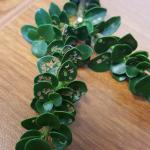
 Redheaded Flea Beetle (Systena frontalis) has been identified as a native pest of nurseries in many locations in the eastern United States. Suspected redheaded flea beetle damage was seen on Ilex crenata 'Dwarf Pagoda' (Dwarf Pagoda Japanese holly) on 3/27/2024 that was purchased in Massachusetts but may have originated in NJ. While identification of this species of insect is uncertain based on host plant damage alone, it appears to be a reasonable and educated assumption. Redheaded flea beetles are known to feed on a wide variety of host plants. These include but are not limited to: cabbage, beans, beets, blueberries, and other agricultural crops as well as Physocarpus, Weigelia, Cornus, Forsythia, Itea, Hydrangea, and Ilex. Adult beetles are active and feed from approximately late-June to mid-September on the upper and lower leaf surfaces of their hosts. This can cause damage that looks like skeletonization and eventually holes in the leaves. Leaves appear covered in brown patches as in these photos. This damage was caused last season on this evergreen plant.
Redheaded Flea Beetle (Systena frontalis) has been identified as a native pest of nurseries in many locations in the eastern United States. Suspected redheaded flea beetle damage was seen on Ilex crenata 'Dwarf Pagoda' (Dwarf Pagoda Japanese holly) on 3/27/2024 that was purchased in Massachusetts but may have originated in NJ. While identification of this species of insect is uncertain based on host plant damage alone, it appears to be a reasonable and educated assumption. Redheaded flea beetles are known to feed on a wide variety of host plants. These include but are not limited to: cabbage, beans, beets, blueberries, and other agricultural crops as well as Physocarpus, Weigelia, Cornus, Forsythia, Itea, Hydrangea, and Ilex. Adult beetles are active and feed from approximately late-June to mid-September on the upper and lower leaf surfaces of their hosts. This can cause damage that looks like skeletonization and eventually holes in the leaves. Leaves appear covered in brown patches as in these photos. This damage was caused last season on this evergreen plant.- Rhododendron Borer is one of the smallest of the native clearwing moths. Adult emergence may begin in May and can last through July, depending upon local temperatures. Rhododendron are preferred host plants, with the larvae of this species boring into stems, often near the base of plants. Injured plant parts may be more attractive to these insects.

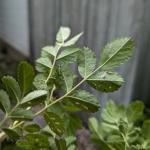 Roseslugs is a common name for at least two species of sawflies whose larvae may be found feeding on the foliage of roses. These small larvae will skeletonize the upper leaf surface and leave a “windowpane”-like pattern behind. If present in large numbers, entire shrubs can be defoliated. Monitor for feeding larvae from the end of May through June. Roseslugs are still feeding as of 5/17/2024 in Williamsburg, MA as pictured here.
Roseslugs is a common name for at least two species of sawflies whose larvae may be found feeding on the foliage of roses. These small larvae will skeletonize the upper leaf surface and leave a “windowpane”-like pattern behind. If present in large numbers, entire shrubs can be defoliated. Monitor for feeding larvae from the end of May through June. Roseslugs are still feeding as of 5/17/2024 in Williamsburg, MA as pictured here.- Southern Pine Beetle has been trapped in Massachusetts since 2015. By 2022 and 2023, southern pine beetle has reached outbreak conditions in small areas of the state, killing pitch pine (Pinus rigida). (Particularly on Martha’s Vineyard and Nantucket islands in MA.) If you believe you have found infested pitch pine in Massachusetts, please report southern pine beetle using the Massachusetts Southern Pine Beetle Reporting Form from MA DCR.
- Spruce Bud Scale overwinters as an immature scale on the undersides of host plant needles. Once spring temperatures warm, the dormant scales become active by late March and in April female spruce bud scales move to host plant twigs. Adult females are reddish-brown and round, and usually found at the base of new twig growth. In this location, they finish maturing and eggs are retained in the female spruce bud scale body cavity where, eventually, crawlers develop. These immature and mobile crawlers appear by approximately the beginning of June and may remain active through July. They then find suitable locations to settle and begin their feeding on the new growth of the plant. During this time, copious amounts of honeydew (sugary liquid excrement) may be excreted.
- Spruce Spider Mite is a cool season mite which causes most of its feeding damage on coniferous hosts in the spring and fall. Monitor for discolored needles and the mites themselves. Monitoring for spruce spider mite can be done by shaking 3-4 branches over a white piece of paper and viewing mites with a hand lens.
- Taxus Mealybug is commonly a pest of Taxus spp. in New England, but can also be found on dogwood, rhododendron, Prunus spp., maple, andromeda, and crabapple. First instar nymphs overwinter, and in April and May it might be difficult to find these insects. However, by mid-June the population can increase considerably. Taxus mealybug feeding can lead to sparse plants covered in honeydew (sugary liquid excrement).
- Tuliptree Scale is a soft scale pest of Liriodendron and Magnolia spp. among others. Second instar nymphs overwinter, begin feeding as temperatures warm in the spring, and mature into adults by the late spring/early summer.
- Viburnum Leaf Beetle larvae may be found anywhere on the leaves and usually in groups. When young, larvae feed on the undersides of the leaves. As they grow larger, they may feed on the upper surface. Larval development may take approximately 8-10 weeks to complete and 3 larval instars are reported. Pupae are yellowish and are found in the soil beneath the host plant. Adults emerge around the middle of July and are brown, smaller than the largest larvae (approximately ¼ inch), and will also feed on the leaves. Adults are present in the landscape until the first hard frost.
- White Pine Aphid is a large, black, long-legged aphid found on twigs and small branches of eastern white pine. Search for aphids beginning in May and June. As the season progresses, honeydew and sooty mold may coat branches and needles of the host plant.
- White Spotted Pine Sawyer is a native longhorned beetle that is often confused for the invasive Asian longhorned beetle (see entry above). White spotted pine sawyer adults emerge in late May throughout July in MA. This insect completes its life cycle in weakened or recently dead conifers, particularly eastern white pine (Pinus strobus). It is not a significant pest. However, if you are unsure of the identification of a longhorned beetle, always take a photo and report it. You can report suspicious insects at the MA Department of Agricultural Resources Introduced Species Outreach Project Report a Pest Form.

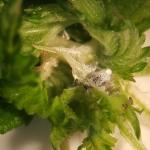 Woolly Apple Aphid overwinters as eggs in the cracks and crevices of Ulmus spp. host plants. As spring temperatures warm, these eggs hatch and stem mothers begin feeding on developing elm leaves. Their feeding and the feeding of the wingless nymphs they produce causes leaf distortion and a rosette to form on elm. If no elm is present, the aphids will complete their life cycle on apple year-round. Woolly apple aphid feeding distortion was seen on new elm foliage on the UMass Amherst campus on 5/1/2024.
Woolly Apple Aphid overwinters as eggs in the cracks and crevices of Ulmus spp. host plants. As spring temperatures warm, these eggs hatch and stem mothers begin feeding on developing elm leaves. Their feeding and the feeding of the wingless nymphs they produce causes leaf distortion and a rosette to form on elm. If no elm is present, the aphids will complete their life cycle on apple year-round. Woolly apple aphid feeding distortion was seen on new elm foliage on the UMass Amherst campus on 5/1/2024.- Woolly Beech Leaf Aphid overwinters as eggs in host plant bark crevices near buds. At budbreak, eggs hatch and wool covered aphids begin feeding on host plant leaf undersides (Fagus spp.). Even though aphid populations may be very noticeable, they seldom require chemical management.
- Woolly Elm Aphid overwinters as eggs hidden in cracks and crevices of elm bark. As leaves unfold in the spring, eggs hatch and young aphids feed on the underside of elm leaf tissue. These aphids mature and give birth to hundreds of additional females. Feeding causes leaves to curl around the aphids. Curled leaves may also turn reddish brown.
- Yellow Poplar Weevil is also known as the sassafrass weevil, the magnolia leafminer, or the tulip tree leafminer. This insect, as all of these common names suggest, feeds on yellow poplar (tulip tree; Liriodendron tulipifera), sassafras (Sassafras albidum), magnolia (Magnolia spp.), as well as bay laurel (Laurus nobilis). Adult beetles lay eggs in the midribs of host plant leaves by May, after which the eggs hatch and larvae feed by creating blotch mines in the leaves. Larvae can be observed in May and June, and adults emerging to feed again by August, prior to overwintering in sheltered areas.
Beneficials/Non-Pests:
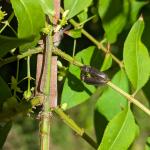 Click Beetles adults were found on burning bush in Chesterfield, MA on 5/28/2024. Adult click beetles are not pests and should be left alone. Click beetle immatures are known as wireworms. Wireworms may be pests of agricultural crops, such as potatoes, onions, carrots, corn, and others.
Click Beetles adults were found on burning bush in Chesterfield, MA on 5/28/2024. Adult click beetles are not pests and should be left alone. Click beetle immatures are known as wireworms. Wireworms may be pests of agricultural crops, such as potatoes, onions, carrots, corn, and others.
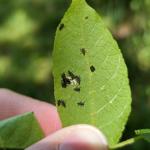 Lady Beetle Larvae were found newly hatched in Chesterfield, MA on 5/28/2024. This is a friendly reminder to observe insects with a hand lens if needed and accurately identify them before considering management options. Lady beetle larvae are voracious predators of many soft bodied insect pests, including aphids, and should be preserved in managed landscapes. Remember: if you kill natural enemies, you inherit their work.
Lady Beetle Larvae were found newly hatched in Chesterfield, MA on 5/28/2024. This is a friendly reminder to observe insects with a hand lens if needed and accurately identify them before considering management options. Lady beetle larvae are voracious predators of many soft bodied insect pests, including aphids, and should be preserved in managed landscapes. Remember: if you kill natural enemies, you inherit their work.
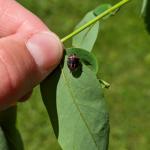 Twice-Stabbed Stink Bug or Cosmopepla lintneriana is also referred to by some as the "wee harlequin bug" or two-spotted stink bug. This polyphagous insect is found across North America and from Canada to Mexico. Very little information is available on this insect, however it has been previously reported in milkweed and most recently in hemp. The twice-stabbed stink bug is thought to have two generations per year with adults overwintering. In general, this insect is not considered a pest to be concerned about.
Twice-Stabbed Stink Bug or Cosmopepla lintneriana is also referred to by some as the "wee harlequin bug" or two-spotted stink bug. This polyphagous insect is found across North America and from Canada to Mexico. Very little information is available on this insect, however it has been previously reported in milkweed and most recently in hemp. The twice-stabbed stink bug is thought to have two generations per year with adults overwintering. In general, this insect is not considered a pest to be concerned about.
Report by Tawny Simisky, Extension Entomologist, UMass Extension Landscape, Nursery & Urban Forestry Program
Landscape Weeds
For information about identification of weeds noted below, check out UMass Extension's Weed Herbarium.
Garlic mustard (Alliaria petiolata): This biennial weed is considered invasive in Massachusetts and other Northeastern states. Second year plants have completed their flowering period and seedpods are still green. Green seedpods contain seeds that are not mature and lack reproductive ability. An herbicide application now will control the second-year plants before they produce via seed as well as the first-year seeding plants that are germinating below the canopy of the second-year plants.
Crabgrass (and other annual grassy weed) management in turf: Monitor turf areas for the emergence of crabgrass and other annual grassy weeds. Routine monitoring should be conducted on all turf areas regardless of whether they received a preemergence herbicide application. After crabgrass has germinated, it can be controlled with several postemergence herbicides. Postemergence herbicides vary in their ability to control crabgrass at different stages of growth (see table below). Determination of the predominant growth stage will dictate appropriate herbicide selection:
Postemergence herbicides for crabgrass control |
||||||
|---|---|---|---|---|---|---|
|
Postemergence Herbicide |
Crabgrass Growth Stage LF = leaf, TL = tiller |
|||||
|
1- to 5-LF |
1-TL |
2-TL |
3-TL |
4-TL |
5-TL & up |
|
|
dithiopyr |
YES |
YES |
YES |
YES |
NO |
NO |
|
mesotrione |
YES |
YES |
YES |
YES |
NO |
NO |
|
quinclorac |
YES |
YES |
NO |
NO |
NO |
YES |
|
fenoxaprop |
YES |
YES |
NO |
NO |
NO |
NO |
Japanese knotweed (Fallopia japonica): Do not attempt to control Japanese knotweed now, as herbicide applications are not effective in the early part of the growing season. In preparation for a late season herbicide application, cut or mow stands of knotweed to the ground in late May and early June. This practice is done to facilitate herbicide application by removing the dried stems from the previous year’s growth and will control plant height to make herbicide treatment easier in late summer. There is also some indication that the plant’s carbohydrate reserves may be reduced with this early season mowing.
Ground ivy (Glechoma hederacea) in turf and landscape: This often “tough-to-manage” weed is currently in full flower or just past full flower. Management of ground ivy is usually not effective during the early part of the growing season. The best control of ground ivy is achieved with an application of a broadleaf turf herbicide product that contains triclopyr in September and October. Ground ivy in landscape beds can be controlled now with a direct-spray application of glyphosate or glufosinate.
Scout for annual weeds in ornamental beds: Recent rainfall and warm weather has pushed summer annual weed germination along. If a preemergence herbicide was applied earlier in the season, now is a good time to begin determining if the application provided effective control. Treat these weeds before they get too large. Spot spraying with a non-selective herbicide (glyphosate or glufosinate) is usually a better strategy than hand-weeding as it does not break the mulch barrier.
Black swallowwort (Cynanchum louiseae syn. Cynanchum nigra) and pale swallowwort (Cynanchum rossicum): Black and pale swallowwort are starting to flower in New England and now is the time to start managing these invasive species with herbicides. Glyphosate usually does not effectively manage swallowwort, so triclopyr is a better choice. Applications of triclopyr are best when applied from early June to the middle of September.
Report by Randy Prostak, Weed Specialist, UMass Extension Landscape, Nursery, and Urban Forestry Program
Additional Resources
Pesticide License Exams - The MA Dept. of Agricultural Resources (MDAR) is now holding exams online. For more information and how to register, go to: https://www.mass.gov/pesticide-examination-and-licensing.
To receive immediate notification when the next Landscape Message update is posted, join our e-mail list or follow us on Facebook.
For a complete listing of landscape, nursery, and urban forestry program upcoming events, see our calendar at https://ag.umass.edu/landscape/upcoming-events.
For commercial growers of greenhouse crops and flowers - Check out UMass Extension's Greenhouse Update website.
For professional turf managers - Check out our Turf Management Updates.
For home gardeners and garden retailers - Check out our home lawn and garden resources.
Diagnostic Services
UMass Laboratory Diagnoses Landscape and Turf Problems - The UMass Extension Plant Diagnostic Lab is available to serve commercial landscape contractors, turf managers, arborists, nurseries and other green industry professionals. It provides woody plant and turf disease analysis, woody plant and turf insect identification, turfgrass identification, weed identification, and offers a report of pest management strategies that are research based, economically sound and environmentally appropriate for the situation. Accurate diagnosis for a turf or landscape problem can often eliminate or reduce the need for pesticide use. For sampling procedures, detailed submission instructions and a list of fees, see the Plant Diagnostic Laboratory web site.
Soil and Plant Nutrient Testing - The University of Massachusetts Soil and Plant Nutrient Testing Laboratory is located on the campus of the University of Massachusetts at Amherst. Testing services are available to all. The lab provides test results and recommendations that lead to the wise and economical use of soils and soil amendments. For more information, including current turn-around times, visit the UMass Soil and Plant Nutrient Testing Laboratory web site. The lab is currently accepting orders for Routine Soil Analysis (including optional Organic Matter, Soluble Salts, and Nitrate testing), Particle Size Analysis, Pre-Sidedress Nitrate (PSNT), Total Sorbed Metals, and Soilless Media (no other types of soil analyses available at this time). Check for current turnaround time. Please plan for the fact that date of receipt in the lab is affected by weekends, holidays, shipping time, and time for UMass Campus Mail to deliver samples to the lab.
Tick Testing - The UMass Center for Agriculture, Food, and the Environment provides a list of potential tick identification and testing options at https://ag.umass.edu/resources/tick-testing-resources.
Acknowledgements: UMass Extension gratefully acknowledges the support of the following funding sources for the production of the Landscape Message –
- The Massachusetts Nursery and Landscape Association Fund
- The Massachusetts Department of Conservation and Recreation, Award #ISADCR28219926UMA24A
- Stakeholders like you! The Landscape Message is partially supported by educational program user fees.